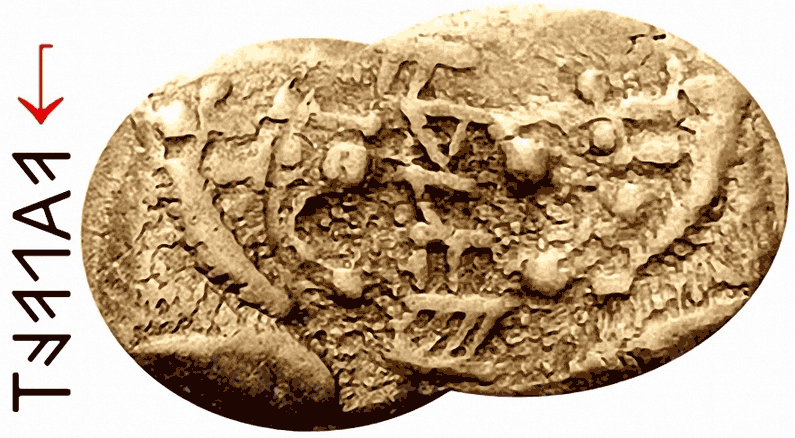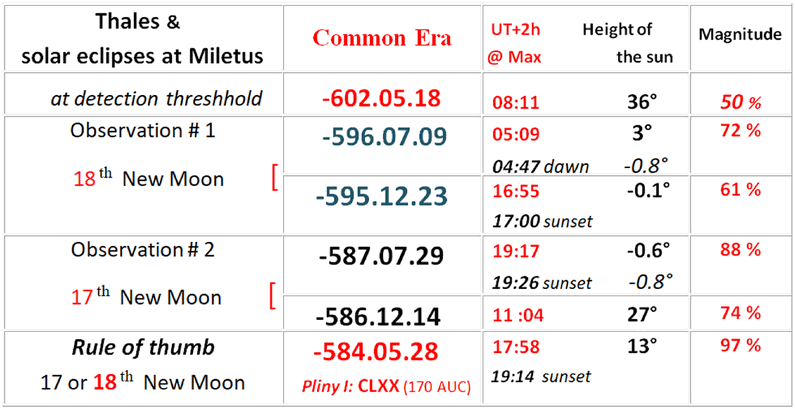When & how did
Science
originate?
Leo Dubal
dubal@archaeometry.org
How
did Thales of Miletus foretell a Solar eclipse without
the help of the Saros cycle? One of the seven sages of antiquity,
Thales was the offspring of an
illustrious
Phoenician family established in Miletus. Thales might
have duly
recorded (in a lost diary) his observations of the occurrence frequency
of Natural
events such as Equinoxes, Solstices, New Moons and Solar
eclipses and made
the best out of those data, finding out rules of
thumb to make sense
out of them. The stories associated to his name
lead to consider him not
only as a talented trader, a smart philosopher, a bold mathematician,
a
legendary astronomer, but,
before all, as the very first scientist. His observations
of
meteorological effects on the growth of olives, after a harsh winter,
let him anticipate
a huge harvest of olives, which made him rich. According to the legend,
during his
trip to Egypt, he realized that the ratio of his height to the length
of his shadow
cast by the sun is the same for the pyramid. He measured this way the
height of
Cheops pyramid, what is today called the Thales’ theorem. One
of his pupils,
Pythagoras, another Phoenician born either in Tyr or Samos, became also
famous
for his advances in geometry and experimental physics. Other renowned
pupils of
his school were Anaximander, Anaxagoras and Heraclitus.
Unfortunately none
original writings of his or from his
contemporary fellows did reach us,
except one coin which carries the name Walwet, the king of
Lydia, called
Alyattes in Greek. Walwet means Lion in Lydian. This coin is the very
first
ever struck. Walwet is written downwards under the guard of two
lion’s heads. This
epigraphic-iconic pattern has been engraved on a hard bronze punch-die.
Its dimension
was too large for the available flans (blank
metal disk),
the
commonly certified 12 mm wide weight of 4,76 g Electrum, also called
Electrum
Trite or Third Stater. The
strike of two
flans has therefore been necessary, each covering the head of a lion,
the name
Walwet, and barely the opposite lion’s mouth. Was it an early
version of the
dollar bill torn apart trick? I
had the
chance to identified two coins [1], [2]
which
have being struck on the same die. The overlap with Photoshop of the
pictures
of those two coins reveals the Royal Electrum Business Card,
with both logo and name, see Fig.1.
 Fig. 1 King WALWET’s
Electrum Business Card:A Photoshop 76% opacity overlap of two Lydian coins
Fig. 1 King WALWET’s
Electrum Business Card:A Photoshop 76% opacity overlap of two Lydian coins
What could well be the link between the
strike of the first coin and Thales? The physicist Göran
Henriksson identified [3]
the
dot on the lion’s eye as a representation of a total solar
eclipse. Indeed, all
coins struck later under Croesus have rays around those solar discs.
At
some New Moon days with clement meteorological conditions, an observer
such as
Thales may have had the chance to see a partial solar eclipse without
any kind
of protection glasses: at dawn or sunset when the
sun is low on the horizon, or, during daytime, by
looking for solar
crescents, cast on the any fair area through foliage
or any 2 mm
diameters holes, or through clouds.

Fig.1
Solar Crescent: a/ at sunset b/
cast on elbow through foliage c/ through clouds
According to the legend, it has
been to king Alyattes that Thales confided his qualified guess concerning the date
of the forthcoming solar eclipse. I suggest that having this trump card
in hand, the Lydian king staged [4] the end of his too long-lasting war
against the Medes, claimed himself shah of shahs, and distribute one
part of his
visit card to his most important allies.
Thales’
qualified guess has being confused by
generations of historians with a scientific prediction! As we know, in
those
old days, such a prediction would simply not have been possible. The neurobiologist W.H. Calvin [5]
suggests: It is potentially quite easy to foretell a
solar eclipse, so long as
you can be wrong half of the time! As Pliny the Elder reported, ½
millennium
after Thales, that the famous eclipse occurred on year CLXX
Ab Urbe
Condita [6], one now knows the exact date -584.05.28.
Since year 2005,
with the released
by Xavier Jubier of a user-friendly freeware coupled to Google Earth,
the 5
Millennium Canon of Solar Eclipses [7], it has been relatively easy for me to find
out how Thales did proceed. In Table 1 are listed the solar eclipses
which occurred
at Miletus.

Table
1: List of Solar eclipses occurring over Miletus which Thales may have
observed, after
X. Jubier’s “5MCSE”,
in the so called
&dT=xxx& url-mode,
see [8].
Systematic observations of New Moons [9]
led to the
following rule of thumb: A solar eclipse
may happen 17 or 18 New
Moons (ca. 502 or 531 days) after a first solar
eclipse [10]. This empirical rule has no scientific
support, though, over a given geographical area, solar eclipses
statistically
have the tendency to cluster in time. According to Table I, in
observation
round #1, after a first solar eclipse, 18 New Moons later another
eclipse
occurred, and, in observation round #2,
17 New Moons later. Therefore, after the -586 solar
eclipse, the best
guess was to wait 17 or 18 New Moons for the possible occurrence of
another
solar eclipse. Indeed Thales has been very lucky, and became famous for
his
prognostic. Between
-602 and -584
solar eclipses Thales might also have notice a span of 18 years (223
lunations).
He might have candidly concluded that the 18 solar years long
cycle is a
scaling up of his 18 New Moons rule of thumb, a kind
of mirror-image
of his theorem of the pyramid ?! Reinforcing this (wrong)
deduction, the
Phoenician trade of colored glass beads with China, may in turn have
conveyed
to Thales the first two entries of Solar eclipses in the Chinese
Chronicles [11]:
on -708.08.17
and on
-600.09.20. He then might have recognized the link
between the 1 X 18
years long period he himself observed and the 6 X 18
years long period the
Chinese astronomers observed? In such a case, he is the one (instead of
unknown
Babylonian astronomers) who should be credited for the discovery of the
SAROS
cycle, not a rule of thumb this time, but a genuine astronomical law.
But it is
also well known that one gives credit only to the rich!
Conclusion :
Indeed Natural Sciences did develop by such systematic
recordings of
observations and finding out rules of thumb to make
sense out of them.
Isn’t that an answer to “When and how did Science originate?” ?
References
click
for the PDF-version
Nîmes / +2023.10.01
Return to index
https://www.archaeometry.org
 Fig. 1 King WALWET’s
Electrum Business Card:A Photoshop 76% opacity overlap of two Lydian coins
Fig. 1 King WALWET’s
Electrum Business Card:A Photoshop 76% opacity overlap of two Lydian coins

